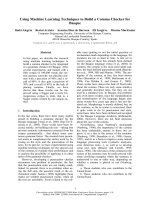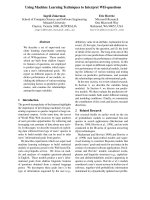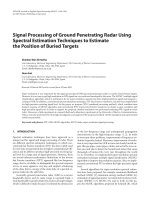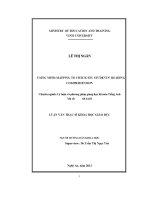Using mind mapping techniques to develop Ly Thuong Kiet high school 11th grade students’ reading text summary skills
Bạn đang xem bản rút gọn của tài liệu. Xem và tải ngay bản đầy đủ của tài liệu tại đây (149.33 KB, 5 trang )
Using mind mapping techniques to develop Ly
Thuong Kiet high school 11th grade students’
reading text summary skills
Nguyễn Thị Thúy Vân
Trường Đại học Ngoại ngữ
Luận văn Thạc sĩ ngành: English teaching methodology; Mã số: 60 14 10
Người hướng dẫn: M.A. Đỗ Bá Quý
Năm bảo vệ: 2012
Abstract. This study was done aiming at finding out the more useful teaching methods
for improving students’ reading text summary skills, testing the effectiveness of using
mind-mapping techniques to develop 11th grade students’ reading text summary skills
compared to conventional techniques and investigating the experimental students’
attitudes towards teaching reading text summary through using mind mapping
techniques. In order to meet the aim of the study, a quasi-experimental research was
conducted in two intact 11th grade classes at Ly Thuong Kiet high school in Hai Phong.
Participants were 80 students (40 students for each class) from class 11B10 and 11B11,
11B10 was labeled the experimental class and 11B11 was the control class. The pretest
and posttest scores were used to measure both classes’ reading text summary
competence before and after the treatment during ten weeks of the second semester of
the 2011-2012 academic school year. And then the post program questionnaire was
designed to get more feedback from experimental students. The results of the pretest
and posttest scores between the two classes were drawn via the descriptive statistics for
Microsoft Excel and the data from questionnaires with 40 experimental students were
then synthesized and analyzed. The findings of the study showed that using mind-
mapping in the post reading stage improved students’ reading text summary skills. On
this basis, the study recommended some directions for further studies on the similar
issues with reference to the context of high school in Vietnam.
Keywords. Tiếng Anh; Phương pháp giảng dạy; Bài đọc; Lớp 11; Phổ thông trung học;
Biểu đồ tư duy
Content
1. Rationale for the study
Nowadays, English is a compulsory subject in the school curriculum in Vietnam, and the
teaching and learning of that international language has been recently paid great attention to.
Together with teachers’ help and guidance, students have to try their best to master 4 language
skills: reading, writing, listening and speaking in order to communicate in English successfully.
Among these four skills, reading skill is an essential skill for further learning. Especially, reading
text summary skills after reading is very beneficial to students to gain better understanding and
memorizing of the text. Thus, students can consolidate or reflect upon what has been read and
relate it to their own knowledge. In addition, reading text summary contributes enormously to
develop writing, speaking and listening skills. However, reading text summary is not easy for
students to do. It needs more useful techniques to help students summarize texts easily. Because
there are still a large number of students having poor reading comprehension not only in rural
areas but also in urban ones.
As a teacher of Ly Thuong Kiet high school (LTKHS), I find that teaching and learning
reading comprehension here still focus on grammar, vocabulary and structures. Hence, students
always find it difficult to understand the content of the reading text, to find the main idea,
synonym or antonym of the words, and general message of the text and most of them lack of
motivation to read. Beside that, there are still many teachers who seem not to pay enough
attention to the importance of teaching reading text summary in post reading stage due to the
limited time. Consequently, Students can not remember and summarize the text after reading.
From the above reasons, I decided to choose
: “
Using mind-mapping techniques to
develop LTK High school 11
th
grade students’ reading text summary skills” for my thesis of the
MA course to help students read the text effectively and can summarize the text easily.
Hopefully, this study will make a small contribution to the application of teaching
reading text summary approach in the post reading stage at Vietnamese high schools in
general
and at LTK high school in Hai Phong in particular.
2. Aims of the study
The aims of this study are to find out the more useful teaching methods for improving
students’ reading text summary skills. To be more specific, the primary objectives of the study
were set up as follows:
- To test the effectiveness of using mind-mapping techniques to develop 11
th
grade
students’ reading text summary skills compared to conventional techniques.
- To investigate the experimental students’ attitudes towards teaching reading text
summary through using mind mapping technique.
3. Research hypothesis and questions
To achieve the aims and objectives, the study was designed to test the hypothesis:
Teaching reading text summary in post reading stage through mind mapping techniques
is more effective to the development of students’ summary skills than the traditional approach
which emphasizes the memorization of words and contents of the reading passage.
In order to find out whether the research hypothesis would be accepted or rejected, the
following research questions were formulated and to be answered.
1. Why is using mind mapping techniques effective to improve students’ reading text
summary skills?
2. What are the students’ attitudes towards teaching reading text summary in post reading
stage through mind mapping techniques after the experimental period?
4. Method of the study
This study was conducted based on quasi-experimental research with pretest, posttest,
and questionnaire in order to determine the causal relationship between teaching reading text
summary through mind mapping and the enhancement of students’ summary skills.
Two groups of students were not chosen randomly, they were two intact groups of
students involved in the study, one group was labeled the control group and the other the
experimental group.
5. Significance of the study
Summarizing the reading text in the textbook series for high schools is presented in a
traditional way which often focuses on the sentence based summarization. Thus, this study will
give an answer to the question whether it is practical to teach reading text summary in the post
reading stage through using mind mapping technique in the context of the high school in
Vietnam.
6. Scope of the study
The study was designed to test the hypothesis that it is possible to teach reading text
summary presented in the textbook through mind mapping. Because of the time constraint, the
researcher could just carry out an experimental research upon a small sample of 11
th
grade
students who were not randomly chosen to a control class and an experimental class, (40 students
for each class) at LTK High school. The pretest and posttest scores were used to measure both
groups’ reading text summary competence before and after the treatment during ten weeks of the
second semester of the 2011-2012 academic year. The post program questionnaire was designed
to get more feedback from experimental students.
7. Organization of the study
The study was divided into three parts which are presented as follows:
Part
A
is
the introduction, which presents the rationale and the aim of the study, hypothesis and
questions, research method, significance, scope as well as organization of the study.
Part B
is
the development, which includes 3 chapters.
Chapter 1
reviews the literature relevant to the study which consists of reading, reading
comprehension, summary, and mind mapping techniques based on theoretical and practical
evidence.
Chapter 2 presents information about the context of the study, the participants, the
instruments, the data collection procedure and data analysis procedure.
Chapter 3
is the main part of the study that reports and discusses the main findings
according to research matter.
Part C
is the conclusion that presents the author’s reflection and the outcomes of the study as
well as indicates some limitations of the study, and finally gives some suggestions for further
research.
References
1. Antonacci, P. (1988). Comprehension Strategies for Special Learners. Reading for Special
Learners. Norwood, NJ: Abex Publishing Corporation.
2. Antonacci, P. (1991). Students Research for Meaning in the text through semantic mapping.
Social Education.
3. Brown, H. D. (2001). Principles of Language Learning and Teaching, 5th ed, Addison
Wesley Longman, New York.
4. Buzan, Tony. (2006). Buku Pintar Mind Map untuk Anak : Agar Anak Mudah Menghafal dan
Berkonsentrasi. Jakarta. PT. Gramedia Pustaka Utama
5. Buzan, Tony. (2007). Mind Maps for kids: Max Your Memory and Concentration .
6. Buzan, Tony. (2010). The mind map book: Unlock Your Creativity, Boost Your Memory,
Change Your Life. 1st ed, BBC Worldwide. England.
7. Byrne, D. (1987). Teaching writing skills. England. Longman.
8. Campbell, D.T. and Stanley, J. C. (1966). Experimental and Quasi-Experimental Designs for
Research. Chicago, IL: Rand McNally.
9. Cook, T.D. & Campbell, D.T. (1979). Quasi-experimentation: design and analysis issues for
field settings. Boston: Houghton Mifflin Co.
10. Coolidge, F. L. 2000. Statistic: A Gentle Introduction. London: SAGE Publication Inc.
11. DePorter, Bobbi and Mike Hernacki. (2008). Quantum Learning: Membiasakan Belajar
Nyaman dan Menyenangkan. Jakarta. Kaifa
12. Doff, A. (1998). Teaching English: A training Course for Teachers. Cambridge: Cambridge
University Press.
13. Effendi, Yusuf. (2004). “The Effectiveness of Mind Mapping Technique in Increasing the
Second Year Students’ reading Comprehension at SLTP Negeri 43 Palembang.” Unpublished
Undergraduated Thesis. Palembang: Faculty of Teacher Training and Education University of
PGRI Palembang.
14. Grellet, F. (1981). Developing Reading Skills. Mc Graw-Hill, Inc.
15. Gardner, RC. (1985). Social Psychology and Second Language Learning: The roles of
attitudes and motivation. London: Edward Arnold.
16. Goodman. (1971). Psycholinguistic universals in reading process, in Paul Pimsleur and
T.Quinn (eds.) The Psychology of Second Language learning. Cambridge University Press.
17. Harmer. J. (1989). The practice of English Language Teaching. 1st ed. Longman.
18. Harmer. J. (2001). The practice of English Language Teaching. 3rd ed. Longman.
19. Hermalasari, 2008, Teaching Writing Paragraphs by using Mind Mapping Technique to the
Eleventh Students of SMA Negeri 14 Palembang.” Unpublished Undergraduated Thesis.
Palembang: Faculty of Teacher Training and Education University of PGRI Palembang.
20. Hoàng Văn Vân, Hoàng Thị Xuân Hoa, Đỗ Tuấn Minh, Nguyễn Thu Phương, Nguyễn Quốc
Tuấn. ( 2007) Tiếng Anh 11. Nhà xuất bản Giáo dục, Việt Nam.
21. Hofland, C. (2007). Mind Mapping in EFL Classroom. Fontys Teacher Training College
Sittart. Fontys Hogestrolen.
22. Lewis, M. and Hill, J. (1992). Practical techniques for language teaching. Language
Teaching Publications.
23. Marton, F. & Booth, S. (1997). Learning and Awareness. Lawrence Erlbaum Associates,
Publishers.
24. Murley, Diane. (2007). Mind Mapping Complex Information, Law library Journal. Vol. 99.
pp. 175-183.
25. Nunan, D. (1991). Language Teaching Methodology: a Textbook for teachers. New York:
Prentice Hall.
26. Nunan, D. (1992). Research Methods in Language Teaching. Cambridge: Cambridge
University Press.
27. Nuttall, C. (1982). Teaching Reading Skills in a Foreign Language. 1st ed. Oxford:
Heinemann.
28. Nuttall, C. (2000). Teaching Reading Skills in a Foreign Language. 2nd ed. Oxford:
Heinemann.
29. Paul Emmerson. (2010) in the article “Using Mind Map in BE-2010”
30. Roe, Stood & Burns. (1987). The Content Areas. Houghton Mifflin Company.
31. Sarada. M. (2008). The Complete guide paragraph to essay writing. An invaluable aid to
master the art of writing for specific purposes. 3
rd
edition Sterling publishers Rt. Ltd, New Delhi.
32. Suharsimi Arikunto. (1998). Dasar-Dasar Evaluasi Pendidikan (Edisi Revisi). Jakarta:
Bumi Aksara.
33. Swales, John M. and Christine B. Feat. (1994). Academic Writing for Graduate Students,
Essential Tasks and Skills. Ann Arbor: U Michigan P.105-130.
34. Trianto, M.Pd. (2009). Mendesain Model Pembelajaran Inovatif: Konsep, Landasan, dan
Implementasinya pada Kurikulum Tingkat Satuan Dasar Pendidikan (KTSP). Jakarta. Kencana.
35. Troyka, L.Q. (1995). Simon and Schuster Handbook for Writers. (4
th
ed.) Englewood Cliffs,
NJ: Prentice-Hall.
36. Williams, E. (1984). Reading in the Language Classroom. New York: Macmillan,









